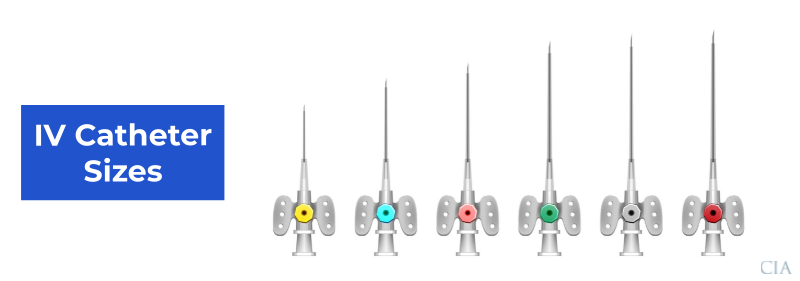

Guide to IV Catheter Sizes: Gauge, Diameter, Length, Flow Rate
IV catheters are crucial components for IV therapy. They allow for the transfer of fluids and medications from IV bags and containers into the body, and they can be used for treating patients in various situations, from surgeries and operations to the treatment of chronic conditions.
However, in order to get the best results and highest levels of safety when using IV catheters, it’s important to choose the appropriate size. There are various sizes of IV catheters, measured using the gauge system, in which each gauge corresponds to a specific outer diameter and maximum flow rate.
In this article, we’ll take a look at the various catheter sizes, explaining the specific dimensions of each size and looking at the most common uses of each IV catheter size, as well.
What Are the Different IV Catheter Sizes?
Catheters are primarily measured according to the gauge system, which is also used for measuring certain needles and other forms of medical tubing. The system is relatively easy to understand, as gauges for IV catheters range from 14 to 26 and proceed in increments of two, with higher numbers being narrower in diameter.
Each gauge number corresponds to a specific diameter, and a color-coding system is used to help medical personnel easily identify a specific gauge of IV catheter. Read on to learn more about exactly how big each gauge of IV catheter is, what maximum flow rate it has, and the average lengths for each kind of catheter, as well as main uses of each size.
14 Gauge Catheters
14 gauge catheters are the largest variety of IV catheters, measuring 2.1mm in external diameter. They typically measure 45mm in length and have a maximum flow rate of around 250 ml/min. These catheters have the orange color code and are mainly used for blood transfusions for patients who have lost blood due to injuries or during surgery.
16 Gauge Catheters
16 gauge catheters measure 1.8mm in external diameter. They’re usually around 45mm in length and have a maximum flow rate of approximately 200 ml/min. They are gray in color and are used when fluids need to be sent into the body quickly and in relatively high quantities. They may also be used for blood transfusions.
18 Gauge Catheters
18 gauge catheters are 1.3mm in size and around 32mm in length. They’re among the most common kinds of IV catheters for adult patients, used for blood transfusions and fluid replacements. They have a maximum flow rate of around 100 ml/min. Color coding for these catheters is green.
20 Gauge Catheters
20 gauge catheters are 1.1mm in diameter and 32mm in length. They have a top flow rate of around 60-70 ml/min and have pink color coding for easy identification. This is typically the most common catheter size used in many hospitals, and it’s an ideal size for most fluid and medication infusions, as well as blood transfusions.
22 Gauge Catheters
22 gauge catheters are 0.9mm in diameter and around 25mm in length, with a top flow rate of around 30-40 ml/min, along with blue color-coding. Slightly narrower than 20 gauge catheters, 22 gauge catheters are useful for treating elderly or pediatric patients.
24 Gauge Catheters 26 Gauge Catheters
24 gauge catheters have yellow color-coding and are 0.7mm in diameter and 19mm in length, with a maximum flow rate of around 20 ml/min. These narrow IV catheters are almost exclusively used in elderly patients, children, and neonates for blood transfusions and other kinds of infusions.
26 Gauge Catheters
26 gauge catheters are 0.6mm in diameter and 19mm in length, with a top flow rate of around 10-15 ml/min. They are the narrowest form of IV catheter, used for treating pediatrics and newborns or neonates. They have purple color coding.
FAQ
Which Size Catheter Should You Choose?
The right size of catheter to use in each situation will depend on the age of the patient and various other factors, such as the type of therapy being administered. In general, it’s best to select the smallest possible gauge that will accommodate the solution or medication you wish to administer and meet the needs of the patient, as well as the chosen insertion site.
What is the Most Common IV Catheter Size For Adults?
18, 20, and 22 gauge IV catheters are the most common sizes for use in adult patients.
What is the Most Common IV Catheter Size For Neonates?
24 or 26 gauge IV catheters are the most common sizes for neonates.
What is the Most Common IV Catheter Size For Infants?
22, 24, or 26 gauge IV catheters are the most common sizes for infants.
What is the Most Common IV Catheter Size For Pediatrics?
22 or 24 gauge IV catheters are the most common sizes for pediatrics.
What is the Most Common IV Catheter Size For The Elderly?
22 gauge is usually the most commonly selected size for elderly patients.
What is the Smallest Diameter For IV Catheters?
26G is the smallest IV catheter size. Due to its extremely narrow size, this kind of catheter is almost exclusively used for treating newborns or infants.
What is the Biggest Diameter For IV Catheters?
The biggest IV catheter size is 14G. This kind of catheter is primarily used for transfusing thick fluids like blood when an adult patient is suffering severe trauma or undergoing surgery.

